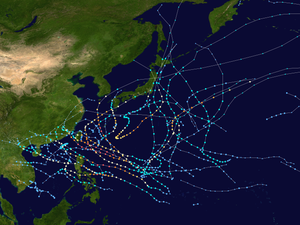
Back Pazifische Taifunsaison 2016 German Temporada de tifones en el Pacífico de 2016 Spanish 2016年の台風 Japanese 2016년 태풍 Korean Musim taufan Pasifik 2016 Malay Temporada de tufões no Pacífico de 2016 Portuguese ฤดูพายุไต้ฝุ่นแปซิฟิก พ.ศ. 2559 Thai Panahon ng bagyo sa Pasipiko ng 2016 Tagalog Mùa bão Tây Bắc Thái Bình Dương 2016 Vietnamese 2016年太平洋颱風季 Chinese
| 2016 Pacific typhoon season | |
|---|---|
 Season summary map | |
| Seasonal boundaries | |
| First system formed | May 25, 2016 |
| Last system dissipated | December 28, 2016 |
| Strongest storm | |
| Name | Meranti |
| • Maximum winds | 220 km/h (140 mph) (10-minute sustained) |
| • Lowest pressure | 890 hPa (mbar) |
| Seasonal statistics | |
| Total depressions | 51 |
| Total storms | 26 |
| Typhoons | 13 |
| Super typhoons | 6 (unofficial)[nb 1] |
| Total fatalities | 942 total |
| Total damage | $16.96 billion (2016 USD) |
| Related articles | |
The 2016 Pacific typhoon season is considered to have been the fourth-latest start for a Pacific typhoon season since reliable records began. It was an average season, with a total of 26 named storms, 13 typhoons, and six super typhoons. The season ran throughout 2016, though typically most tropical cyclones develop between May and October. The season's first named storm, Nepartak, developed on July 3, while the season's last named storm, Nock-ten, dissipated on December 28.
The development of Nepartak made the second-latest time within a season for the first named storm to develop and ended a 199-day period (from December 17, 2015 – July 3, 2016) during which no named storm was active in the basin. Tropical Storm Mirinae reached peak intensity while making landfall over the Red River Delta, causing very severe damage in Northern Vietnam. By the end of August, three storms had hit the Japanese island of Hokkaidō, the most since 1951. In September, Typhoon Meranti reached peak intensity with a minimum pressure of 890 hPa, becoming one of the most intense tropical cyclones on record. Typhoon Chaba became the strongest typhoon to strike South Korea since 2012. Tropical Storm Aere and a tropical depression brought the worst flooding in Vietnam since 2011. The last storm of the season, Typhoon Nock-ten, became the strongest tropical cyclone ever recorded worldwide on Christmas Day (December 25) since at least 1960, in terms of 1-minute maximum sustained winds.
The scope of this article is limited to the Pacific Ocean to the north of the equator between 100°E and 180th meridian. Within the northwestern Pacific Ocean, there are two separate agencies that assign names to tropical cyclones which can often result in a cyclone having two names. The Japan Meteorological Agency (JMA)[nb 2] will name a tropical cyclone should it be judged to have 10-minute sustained wind speeds of at least 65 km/h (40 mph) anywhere in the basin, whilst the Philippine Atmospheric, Geophysical and Astronomical Services Administration (PAGASA) assigns names to tropical cyclones which move into or form as a tropical depression in the Philippine Area of Responsibility (PAR) located between 135°E and 115°E and between 5°N–25°N regardless of whether or not a tropical cyclone has already been given a name by the JMA. Tropical depressions that are monitored by the United States' Joint Typhoon Warning Center (JTWC)[nb 3][nb 1] are given a number with a "W" suffix.
Cite error: There are <ref group=nb> tags on this page, but the references will not show without a {{reflist|group=nb}} template (see the help page).
- ^ "Joint Typhoon Warning Center Mission Statement". Joint Typhoon Warning Center. 2011. Archived from the original on July 26, 2007. Retrieved July 25, 2012.
- ^ Frequently Asked Questions (Report). Joint Typhoon Warning Center. August 13, 2012. Archived from the original on October 4, 2013. Retrieved September 22, 2012.